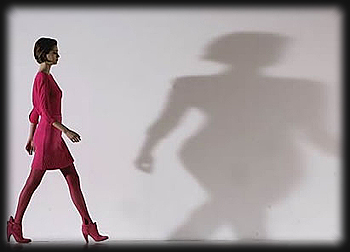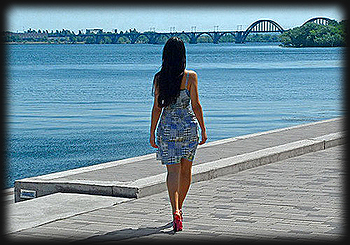How to Walk Like a Diva |
|
No matter how gorgeous you look, if you walk like a man, you will give yourself away. |
|
|
|
Steps |
|
1. Make your posture relaxed, but erect. Pretend that your head is being pulled up by a hair on the crown of your head to elongate your neck, lift your chest, and allow your shoulders to fall back. Also, pretend that there is a string attached to your sternum (breastbone) that lifts your chest toward the sky to hold your ribcage up off of your pelvis and to pull your navel into your back. |
|
|
|
2. Repeat this to yourself in your head: chin up, neck long, shoulders back, chest out, abs tight, pelvis forward, and buttocks tight. At first you may feel that you are leaning back a little and you should be able to feel pressure and length in the small of your back (i.e. the lumbar area of your back which curves between your ribcage and pelvis). Stand tall and breathe calmly through your nose. |
|
|
|
3. Make a conscious but discreet effort to arrange your body as slightly pigeon-toed (i.e. toes pointing forward and inward and heels outward) and slightly knock-kneed (i.e. knees bent and pointing forward and inward and hips outward) and slightly knock-elbowed (i.e. elbows bent and pointing backward and inward to meet behind your spine and bent wrists outward). Let your arms hang with your elbows bent. Your wrists should fall near to the back of your thighs. This stance enhances stability, flexibility and places emphasis on the ultimate feminine attribute (i.e. curvaceous hips). |
|
|
|
4. Make a conscious but discreet effort to arrange your body as slightly pigeon-toed (i.e. toes pointing forward and inward and heels outward) and slightly knock-kneed (i.e. knees bent and pointing forward and inward and hips outward) and slightly knock-elbowed (i.e. elbows bent and pointing backward and inward to meet behind your spine and bent wrists outward). Let your arms hang with your elbows bent. Your wrists should fall near to the back of your thighs. This stance enhances stability, flexibility and places emphasis on the ultimate feminine attribute (i.e. curvaceous hips). |
|
|
|
5. Always have confidence and be fully present in your body. Allow your soul to come out from your eyes, relax your jawline, relax your lips to form an ideal shape. Focus sharply on the present moment, on your personal performance, and on your immediate surroundings (i.e. focus exclusively on one moment at a time, one breath at a time, and one step at a time, as you are immersed in your environment). Present the best possible you in each and every present moment. |
|
|
|
6. Place each leg directly in front of the other leg, the way a cat does. The majority of weight shifts should occur near your center of gravity, which is between your thighs and belly button. Aim for your footprints to form a single line as if you are walking on tightrope. This motion dictates the extent to which your hips and arms swing. Keep your head and shoulders relatively still as your body moves and try to appear as though you are walking into the wind to push your shoulders back and force your pelvis to lead you forward. |
|
|
|
7. Take all steps to the inside edge of the ball of the foot, maintaining a bent knee, and then slightly lowered to the flat of the foot (i.e. ball-flat footwork), to make the steps feel and look like you are pushing into the floor. Synchronize the motion of each bent knee with that of the ball of the foot below it for greater control. Alternatively, you can instead synchronize the motion of each bent knee with that of the heel of the foot below it if you prefer to execute a heel-to-toe strut. |
|
|
|
8. Make your strides more or less pronounced by lifting your legs boldly or subtly in the same manner as a horse trot. Lift your foot a moderate distance off the ground with your knee bent, and then place it down a moderate distance in front of the supporting leg. As a knee bends, the same hip drops (and causes the other hip to rise), and as a knee straightens, the same hip rises (and causes the other hip to drop). If you wish to add a bounce in your walk, do it by making complete weight changes (i.e. allow each hip to abruptly drop when you bend and raise the knee on the same side of your body as your weight is transferred to your hip from the foot below it). |
|
|
|
9. Move as little as possible when performing practical or enticing actions. For example, if you wish to look over at something or someone, move your eyes first until they cannot move any more, then move your head, then your torso and adjust your lower body last and only when necessary. Always return to your most relaxed state and never maintain a tense position. |
|
|
|
10. Appear inviting even when you stand still. Arrange your left foot slightly in front of your right foot (your left knee should be slightly bent), and these toes should point forward and slightly inward with only some of your weight bearing on the ball of this foot. Your right foot should be almost directly behind your left foot and turned to the right to be perpendicular to it, and these toes should point to your right and slightly inward with most of your weight bearing on the ball of this right foot. Attempt to gently bend your knees toward each other to exude more panache. Additionally, your body should be turned to position your right elbow behind your right hip, and you should delicately turn your head toward your nearest shoulder (i.e. your left shoulder) to complete the pose. |
|
Tips |
|
1. Walk to the beat of a song. It keeps your steps even. But don't make it too slow. After listening to a few songs, you should be able to find a good one. |
|
2. Keep your hands open with your fingers nearly totally straightened. Pretend as though you are gently holding a feather from a seagull in each hand and keep all movements fluid. |
|
3. Contra-body action refers to the natural tendency of the ribcage and pelvis to move in opposite directions when a person walks. The natural walking action of humans is for the right arm and shoulder to move backward as the right leg moves forward, and conversely, for the left arm and shoulder to move backward as the left leg moves forward. However, you should try to keep your shoulders still and your elbows positioned just behind your pelvis for more freedom of movement. Further, you should only allow each shoulder blade (i.e. scapula) to subtly fall backward, downward and inward along with the bent elbow on the same side of your body so as to contradict the alternating forward, upward and inward motion of your lower body. |


